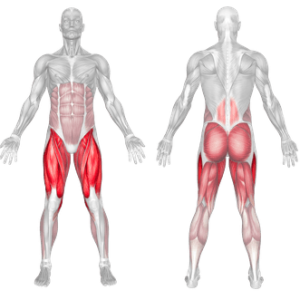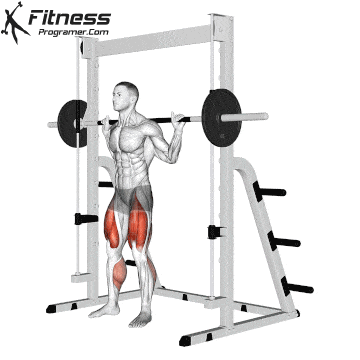Overview
The Smith Machine Squat is a squat variation performed inside a Smith machine, where the barbell moves along fixed rails. This removes the need to balance the bar and allows the user to focus on form, depth, and muscle engagement. While it limits natural bar path, it offers a safe and effective method for building lower body strength, especially in hypertrophy or rehabilitation-focused programs.
How to Perform Smith Machine Squat
To perform the Smith Machine Squat correctly, follow these steps:
Set the bar at upper chest height, and load desired weight. Position your feet slightly in front of the bar.
Step under the bar, place it across your upper traps, and grip just wider than shoulder width.
Unrack the bar by rotating it slightly, then brace your core and stand tall.
Lower into a squat by bending your knees and hips, keeping your chest lifted and knees tracking your toes.
Descend until your thighs are at least parallel to the floor or lower if mobility allows.
Drive through your heels to push back up to the starting position, fully extending the hips and knees.
Repeat for reps, then rerack the bar by rotating it back onto the hooks.
Tips for Proper Form
Keep feet slightly forward: This compensates for the fixed bar path and reduces knee strain.
Engage your core: Stabilize your spine and maintain an upright torso.
Push through the heels: Helps activate glutes and maintain balance.
Set bar on traps, not neck: Prevents strain and maintains better posture.
Control each rep: Avoid bouncing or using momentum at the bottom.
Common Mistakes
Standing directly under the bar: Limits depth and places stress on knees.
Rounding the back: Weak core control can lead to injury.
Lifting the heels: Indicates poor balance and reduces glute involvement.
Too shallow of a squat: Limits muscle engagement and progression.
Letting knees cave inward: Increases injury risk and weakens alignment.
Benefits of the Smith Machine Squat
Provides added safety without a spotter: The fixed path and lockout hooks reduce risk when lifting alone or going heavy.
Supports hypertrophy training: Ideal for controlled reps, time under tension, and volume-based muscle building.
Better Form Focus: With less need for balance, you can focus on squat depth, proper alignment, and muscle activation.
Increased Muscle Activation for Beginners: Beginners can lift slightly heavier with good form, helping them build confidence and foundational strength.
Isolation of Targeted Muscle Groups: Foot and torso positioning can be adjusted to emphasize quads, glutes, or hamstrings with more precision.
Effective for High-Volume Training: The stability allows for safe, high-rep sets and drop sets without worrying about bar control or balance.
Reduced Strain on Lower Back: A more upright torso position limits shear force on the spine, making it joint-friendly for many users.
Quick Setup for Circuit Training: Fast loading and unloading makes it perfect for supersets and circuits without breaking workout flow.
Drawbacks:
1. Limited Range of Motion: The fixed bar path may restrict natural movement, potentially putting strain on the knees or lower back if not performed with the correct form.
2. Reduced Core Engagement: With the stability provided by the Smith machine, the core works less than it would in free-weight squats. Since the machine supports the weight, it demands less stabilization from your core and surrounding muscles.
How to Incorporate Into Your Routine
The Smith Machine squat can be a versatile addition to your leg day routine, whether you’re aiming for muscle growth, strength gains, or endurance. Here are a few ways to incorporate this exercise into your workouts:
- For Beginners: Perform 2-3 sets of 8-10 reps with a lighter weight to master form and control.
- For Hypertrophy: Aim for 3-4 sets of 10-12 reps, focusing on muscle engagement and gradually increasing weight.
- For Strength: Try 4 sets of 4-6 reps with a heavier weight, prioritizing controlled movement and full range of motion.
Muscles Worked

Frequently Asked Questions
Are Smith Machine squats as effective as free-weight squats?
Both variations have unique benefits. While free-weight squats engage stabilizer muscles, the Smith Machine allows for a more controlled movement, which can be beneficial for targeting specific muscles and working on form.
How does foot position affect Smith Machine squats?
Foot placement changes the muscle emphasis. Placing your feet forward can increase glute and hamstring engagement, while keeping feet directly under your body focuses on the quads.
Can I do Smith Machine squats if I have knee pain?
Smith Machine squats can be gentler on the joints, but consult with a medical professional or certified trainer before performing squats if you have knee pain.

